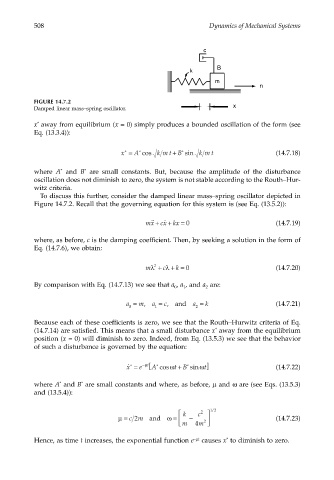Page 527 - Dynamics of Mechanical Systems
P. 527
0593_C14_fm Page 508 Tuesday, May 7, 2002 6:56 AM
508 Dynamics of Mechanical Systems
c
B
k
m
n
FIGURE 14.7.2
Damped linear mass–spring oscillator. x
x away from equilibrium (x = 0) simply produces a bounded oscillation of the form (see
*
Eq. (13.3.4)):
+
x = A cos km t B sin km t (14.7.18)
*
*
*
*
*
where A and B are small constants. But, because the amplitude of the disturbance
oscillation does not diminish to zero, the system is not stable according to the Routh–Hur-
witz criteria.
To discuss this further, consider the damped linear mass–spring oscillator depicted in
Figure 14.7.2. Recall that the governing equation for this system is (see Eq. (13.5.2)):
+
+
˙˙
˙
mx cx kx = 0 (14.7.19)
where, as before, c is the damping coefficient. Then, by seeking a solution in the form of
Eq. (14.7.6), we obtain:
mλ + cλ + = 0 (14.7.20)
2
k
By comparison with Eq. (14.7.13) we see that a , a , and a are:
0
1
2
a = m, a = c, and a = k (14.7.21)
0 1 2
Because each of these coefficients is zero, we see that the Routh–Hurwitz criteria of Eq.
*
(14.7.14) are satisfied. This means that a small disturbance x away from the equilibrium
position (x = 0) will diminish to zero. Indeed, from Eq. (13.5.3) we see that the behavior
of such a disturbance is governed by the equation:
ω
−µ
x = e [ A * cos t B+ω * sin t] (14.7.22)
t
˙ *
*
*
where A and B are small constants and where, as before, µ and ω are (see Eqs. (13.5.3)
and (13.5.4)):
/
2
µ = cm and ω = k − c 2 12 (14.7.23)
m 4 m 2
*
–µt
Hence, as time t increases, the exponential function e causes x to diminish to zero.

